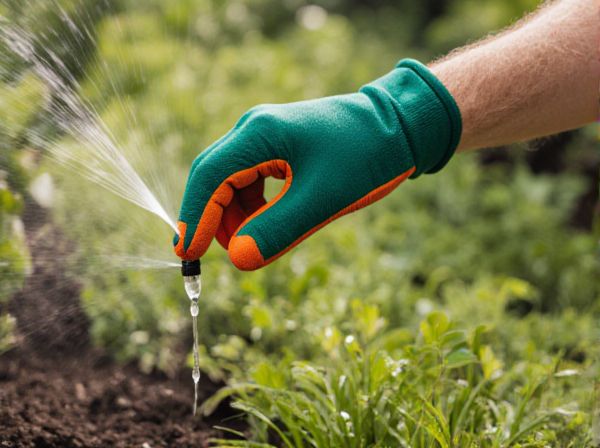
Drip irrigation vs Overhead sprinkler irrigation Illustration
Drip irrigation delivers water directly to the root zone, reducing water waste and minimizing fungal diseases in edible crops compared to overhead sprinkler irrigation. Overhead sprinkler systems can promote leaf wetness, increasing the risk of disease and nutrient run-off, which negatively affects crop quality and yield. Efficient water use with drip irrigation enhances growth while conserving resources in edible plant cultivation.
Table of Comparison
| Feature | Drip Irrigation | Overhead Sprinkler Irrigation |
|---|---|---|
| Water Efficiency | High - delivers water directly to roots, reducing evaporation | Moderate - water loss due to evaporation and wind drift |
| Cost | Higher initial installation cost | Lower installation cost but higher water use |
| Suitability for Edible Crops | Ideal for vegetables, fruits, and row crops | Suitable for broad coverage of various crops |
| Water Distribution | Localized, precise watering | Uniform coverage over larger area |
| Maintenance | Requires frequent filter cleaning and system checks | Less frequent, easier maintenance |
| Disease Risk | Lower - reduces leaf wetness | Higher - wet foliage can increase disease incidence |
| Soil Erosion | Minimal risk | Moderate risk due to water impact |
Introduction to Drip and Overhead Sprinkler Irrigation
Drip irrigation delivers water directly to the plant root zone through a network of valves, pipes, tubing, and emitters, maximizing water efficiency and reducing evaporation. Overhead sprinkler irrigation mimics natural rainfall by dispersing water over the crop canopy through rotating or fixed sprinklers, enabling uniform coverage over large areas. Both methods vary in water usage, application precision, and suitability depending on crop type and soil conditions.
Water Efficiency: Drip vs. Overhead Sprinkler
Drip irrigation delivers water directly to plant roots, reducing evaporation and runoff, resulting in water use efficiency of up to 90%. Overhead sprinkler systems spray water over a wide area, leading to significant evaporation losses and water waste, especially under windy or hot conditions. Studies show drip irrigation can save 30-50% more water compared to overhead sprinklers, making it ideal for conserving water in edible crop production.
Impact on Crop Yield and Plant Health
Drip irrigation delivers water directly to the root zone, enhancing water efficiency and promoting healthier plant growth, which often leads to higher crop yields compared to overhead sprinkler irrigation. Overhead sprinklers can increase the risk of foliar diseases due to leaf wetting and may cause water loss through evaporation, potentially reducing overall plant health and yield. Research indicates that crops such as tomatoes and lettuce show improved growth metrics and reduced disease incidence under drip irrigation systems.
Installation Complexity and Maintenance Needs
Drip irrigation systems require precise installation involving a network of tubes, emitters, and filters to deliver water directly to plant roots, demanding careful planning and initial setup. Maintenance involves regular flushing of lines and emitter checks to prevent clogging, which can be more labor-intensive compared to overhead sprinklers. Overhead sprinkler irrigation generally features simpler installation with coverage over broad areas but requires frequent maintenance to address nozzle wear, water distribution uniformity, and potential damage from environmental factors.
Suitability for Different Edible Crops
Drip irrigation is highly suitable for row crops such as vegetables, fruits, and herbs, delivering water directly to the root zone, which reduces water waste and minimizes disease risk. Overhead sprinkler irrigation is more appropriate for leafy greens, grains, and larger field crops that benefit from uniform water distribution over a broad area. Crop type, soil moisture requirements, and local climate conditions significantly influence the choice between these irrigation methods for optimal edible crop production.
Cost Comparison: Initial and Long-Term Investment
Drip irrigation systems typically require a higher initial investment due to the cost of emitters, tubing, and installation, but they offer significant water savings and reduced labor expenses over time. Overhead sprinkler irrigation generally involves lower upfront costs and simpler setup but leads to higher water usage and maintenance expenses in the long run due to evaporation and runoff. Evaluating the total cost of ownership reveals that drip irrigation delivers better cost-efficiency and sustainability for edible crop cultivation.
Disease Prevention and Foliage Management
Drip irrigation delivers water directly to the root zone, significantly reducing leaf wetness and minimizing the risk of foliar diseases compared to overhead sprinkler irrigation. Overhead sprinklers wet the foliage, creating a humid environment conducive to fungal and bacterial infections that can compromise plant health and crop quality. Effective foliage management benefits from drip irrigation's targeted water application, promoting better air circulation and reducing disease incidence in edible crops.
Soil Erosion and Nutrient Retention
Drip irrigation significantly reduces soil erosion by delivering water directly to the root zone, minimizing surface runoff and preserving topsoil structure. This method enhances nutrient retention as nutrients remain concentrated in the root area, preventing leaching and promoting efficient plant uptake. In contrast, overhead sprinkler irrigation often causes surface runoff and nutrient wash-off, increasing soil erosion and nutrient loss from the root zone.
Automation and System Control Features
Drip irrigation systems offer advanced automation capabilities with precise control over water delivery directly to plant roots, reducing water waste and improving efficiency. Overhead sprinkler systems generally enable broader area coverage but often lack fine-tuned control, relying on timer-based schedules with less adaptability to varying soil moisture levels. Integration of smart sensors and IoT technology is more seamless in drip irrigation, facilitating real-time monitoring and remote management for optimized crop hydration.
Environmental Impact and Water Conservation
Drip irrigation minimizes water wastage by delivering moisture directly to plant roots, significantly reducing evaporation and runoff compared to overhead sprinkler systems, which often lose substantial water to wind drift and surface runoff. This targeted watering technique conserves freshwater resources and decreases the energy required for water pumping, leading to a lower carbon footprint. Overhead sprinklers, while effective for large-scale coverage, typically result in higher water consumption and increased nutrient leaching, contributing to soil erosion and water pollution.
Drip irrigation vs Overhead sprinkler irrigation Infographic

 gardendif.com
gardendif.com